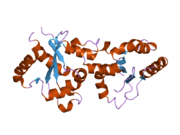Toll-like_receptor_10
| TLR10 | |||||||||||||||||||||||||||||||||||||||||||||||||||
|---|---|---|---|---|---|---|---|---|---|---|---|---|---|---|---|---|---|---|---|---|---|---|---|---|---|---|---|---|---|---|---|---|---|---|---|---|---|---|---|---|---|---|---|---|---|---|---|---|---|---|---|
 | |||||||||||||||||||||||||||||||||||||||||||||||||||
| |||||||||||||||||||||||||||||||||||||||||||||||||||
| Identifiers | |||||||||||||||||||||||||||||||||||||||||||||||||||
| Aliases | TLR10, CD290, toll like receptor 10 | ||||||||||||||||||||||||||||||||||||||||||||||||||
| External IDs | OMIM: 606270 HomoloGene: 12809 GeneCards: TLR10 | ||||||||||||||||||||||||||||||||||||||||||||||||||
| |||||||||||||||||||||||||||||||||||||||||||||||||||
| |||||||||||||||||||||||||||||||||||||||||||||||||||
| |||||||||||||||||||||||||||||||||||||||||||||||||||
| |||||||||||||||||||||||||||||||||||||||||||||||||||
| Wikidata | |||||||||||||||||||||||||||||||||||||||||||||||||||
| |||||||||||||||||||||||||||||||||||||||||||||||||||
Toll-like receptor 10 is a protein that in humans is encoded by the TLR10 gene.[3] TLR10 has also been designated as CD290 (cluster of differentiation 290). TLR10 has not been extensively studied because it is a pseudogene in mice, though all other mammalian species contain an intact copy of the TLR10 gene. Unlike other TLRs, TLR10 does not activate the immune system and has instead been shown to suppress inflammatory signaling on primary human cells.[4] This makes TLR10 unique among the TLR family. TLR10 was thought to be an "orphan" receptor, however, recent studies have identified ligands for TLR10 and these include HIV-gp41.[5] Ligands for TLR2 are potential ligands for TLR10.[6]
Function
The protein encoded by this gene is a member of the toll-like receptor (TLR) family which play a fundamental role in pathogen recognition and activation of innate immunity. TLRs are highly conserved from Drosophila to humans and share structural and functional similarities. They recognize pathogen-associated molecular patterns (PAMPs) that are expressed on infectious agents, and mediate the production of cytokines necessary for the development of effective immunity.
TLR10 is unique among the TLR family in having an anti-inflammatory function, rather than a pro-inflammatory function. This was discovered by over-expressing TLR10 in human cell lines and using antibody-mediated engagement of the receptor on primary human cells. When TLR10 is activated in this manner, it suppresses the amount of cytokines produced, as compared to control cells. TLR10 engagement also has long-term effects on monocyte and B cell activation/differentiation by suppressing the transcription of activation markers. TLR10's mechanism of action is not yet known but activation of the receptor has been shown to suppress NF-κB, MAP kinase and Akt signaling events stimulated by TLR and CD40 ligands.[7] Currently, no ligand has been identified for this receptor. However, the computational analysis reported that TLR10 can interact with peptidoglycan and (triacyl) lipopeptides in concert with TLR2 (as a heterodimer).[8]
Some ligands of TLR10 have been recently described: HIV-1 gp41, H. pylori LPS (TLR2/10), L. monocytogenes, B burgdorferi, H1N1/H5N1.[9]
Expression
TLR10 has been transcriptionally shown to be expressed in secondary lymphoid tissues such as the spleen, lymph nodes, and tonsils. More specifically, protein level expression of TLR10 has been shown on the surface of B cells, monocytes and neutrophils; but not on T cells. Monocytes have the highest expression of TLR10 among these cell types but the overall expression of TLR10 is low compared to other TLRs. TLR10 has also been shown to be produced intracellularly in neutrophils and B cells differentiating into plasma cells.
Multiple alternatively spliced transcript variants encoding the same protein have been found for this gene.[10]
References
- ^ a b c GRCh38: Ensembl release 89: ENSG00000174123 - Ensembl, May 2017
- ^ "Human PubMed Reference:". National Center for Biotechnology Information, U.S. National Library of Medicine.
- ^ Chuang T, Ulevitch RJ (Mar 2001). "Identification of hTLR10: a novel human Toll-like receptor preferentially expressed in immune cells". Biochim Biophys Acta. 1518 (1–2): 157–61. doi:10.1016/s0167-4781(00)00289-x. PMID 11267672.
- ^ Jiang S, Li X, Hess NJ, Guan Y, Tapping RI (May 2016). "TLR10 is a Negative Regulator of Both MyD88-Dependent and -Independent TLR Signaling". Journal of Immunology. 196 (9): 3834–3841. doi:10.4049/jimmunol.1502599. PMC 4868647. PMID 27022193.
- ^ Fore, Faith; Indriputri, Cut; Mamutse, Janet; Nugraha, Jusak (2020). "TLR10 and Its Unique Anti-Inflammatory Properties and Potential Use as a Target in Therapeutics". Immune Network. 20 (3): e21. doi:10.4110/in.2020.20.e21. ISSN 1598-2629. PMC 7327153. PMID 32655969.
- ^ Su, Si‐Biao; Tao, Lin; Deng, Ze‐Ping; Chen, Wen; Qin, Shan‐Yu; Jiang, Hai‐Xing (April 2021). "TLR10: Insights, controversies and potential utility as a therapeutic target". Scandinavian Journal of Immunology. 93 (4): e12988. doi:10.1111/sji.12988. ISSN 0300-9475. PMID 33047375.
- ^ Hess NJ, Jiang S, Li X, Guan Y, Tapping RI (Jan 2017). "TLR10 Is a B Cell Intrinsic Suppressor of Adaptive Immune Responses". Journal of Immunology. 198 (2): 699–707. doi:10.4049/jimmunol.1601335. PMC 5225023. PMID 27956526.
- ^ Govindaraj RG, Manavalan B, Lee G, Choi S (September 2010). "Molecular Modeling-Based Evaluation of hTLR10 and Identification of Potential Ligands in Toll-Like Receptor Signaling". PLOS ONE. 5 (9): e12713. Bibcode:2010PLoSO...512713G. doi:10.1371/journal.pone.0012713. PMC 2943521. PMID 20877634.
- ^ Sartorius R, Trovato M, Manco R, D'Apice L, De Berardinis P (October 2021). "Exploiting viral sensing mediated by Toll-like receptors to design innovative vaccines". npj Vaccines. 6 (1): 127. doi:10.1038/s41541-021-00391-8. PMC 8553822. PMID 34711839.
- ^ "Entrez Gene: TLR10 toll-like receptor 10".
Further reading
- Lien E, Ingalls RR (2002). "Toll-like receptors". Crit. Care Med. 30 (1 Suppl): S1–11. doi:10.1097/00003246-200201001-00001. PMID 11782555.
External links
- Toll-Like+Receptor+10 at the U.S. National Library of Medicine Medical Subject Headings (MeSH)
- Overview of all the structural information available in the PDB for UniProt: Q9BXR5 (Toll-like receptor 10) at the PDBe-KB.


